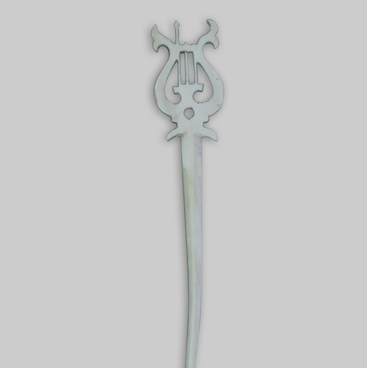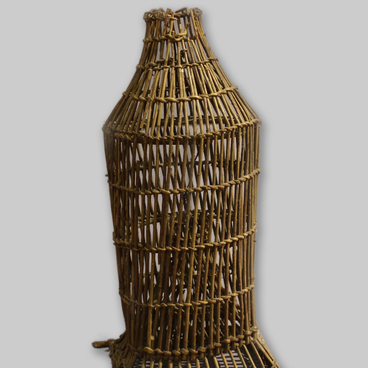Metal muzzle — a fishing trap which has the look and principle of the wooden muzzle. The only difference is the material of the main frame of the tackle. Wooden traps were made mainly from red willow twigs soaked in boiling water for flexibility, while metal ones were made from strong wire.
The image of an old broken muzzle tied to a load-stone and abandoned on the shore can be seen in the foreground of the painting ‘Barge Haulers on the Volga’ by Russian artist Ilya Repin. In 1868, the young painter was so impressed by the sight of dirty and ragged hired workers on the Neva that he decided to create a large-scale canvas about the life of ordinary Russian people. He spent some time on the Volga river in Samara region in order to get acquainted with the work of barge haulers.
Usually the muzzle was used for fishing near the shore — it was thrown into a thicket of reeds and sedge or installed in a narrow place of the river, tied with a rope to a tree or peg. Before lowering it into the water, fir branches were attached to the base of the inner cone — they served as bait for future prey. Loads were hung to the muzzle to prevent the trap from floating up. The hole in the upper cone was plugged with hay and lowered into the water with weights down. The base of the muzzle was directed in the direction of the reservoir, where the fish comes from. The principle of the trap was that the fish that had swum inside could no longer swim out of it.
Almost all modern fishermen know the device of such a tackle — many of them used muzzles at the end of the Soviet period, and some use them till this day. Similar, but more advanced traps are now widespread, for example, vertices and venteri. Fishing with such devices loses its venturesome component, but a good catch is almost always provided. However, fishing with a muzzle and similar gear is not allowed in all water bodies of Russian regions.
Fishing and hunting were the main occupations of most Ket in the XIX century, while the northern Ket fishing prevailed — fish was caught all year round. In recent decades, there have been significant changes in the way of life of the indigenous population, and livestock and truck farming have come to the fore. Currently, about 46 species and subspecies of fish and one fish-like species live in the reservoirs of the Yenisey basin — fast currents, rocky-pebble bottom, and low temperatures negatively affect the development of the aquatic fauna and flora of the river.
The image of an old broken muzzle tied to a load-stone and abandoned on the shore can be seen in the foreground of the painting ‘Barge Haulers on the Volga’ by Russian artist Ilya Repin. In 1868, the young painter was so impressed by the sight of dirty and ragged hired workers on the Neva that he decided to create a large-scale canvas about the life of ordinary Russian people. He spent some time on the Volga river in Samara region in order to get acquainted with the work of barge haulers.
Usually the muzzle was used for fishing near the shore — it was thrown into a thicket of reeds and sedge or installed in a narrow place of the river, tied with a rope to a tree or peg. Before lowering it into the water, fir branches were attached to the base of the inner cone — they served as bait for future prey. Loads were hung to the muzzle to prevent the trap from floating up. The hole in the upper cone was plugged with hay and lowered into the water with weights down. The base of the muzzle was directed in the direction of the reservoir, where the fish comes from. The principle of the trap was that the fish that had swum inside could no longer swim out of it.
Almost all modern fishermen know the device of such a tackle — many of them used muzzles at the end of the Soviet period, and some use them till this day. Similar, but more advanced traps are now widespread, for example, vertices and venteri. Fishing with such devices loses its venturesome component, but a good catch is almost always provided. However, fishing with a muzzle and similar gear is not allowed in all water bodies of Russian regions.
Fishing and hunting were the main occupations of most Ket in the XIX century, while the northern Ket fishing prevailed — fish was caught all year round. In recent decades, there have been significant changes in the way of life of the indigenous population, and livestock and truck farming have come to the fore. Currently, about 46 species and subspecies of fish and one fish-like species live in the reservoirs of the Yenisey basin — fast currents, rocky-pebble bottom, and low temperatures negatively affect the development of the aquatic fauna and flora of the river.



